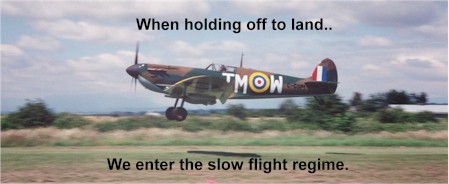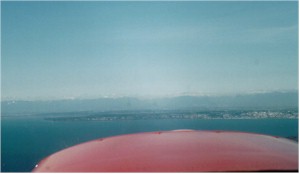
The 152 can be flown at airspeeds as low as 57 Knots, and as high as 149 Knots. High speeds give excellent controllability, but at low airspeeds the aeroplane needs careful and gentle handling.
To land an aeroplane on a runway gracefully you will need to slow down while raising the nose so that only the main wheels touch down. As you slow down just above the ground, raising the nose increases the angle of attack of the wings (this is called Holding Off), until the landing attitude is reached, and with the consequent reduction of lift the aeroplane descends gently onto its wheels… To do this you’re going to need a lot of practice!

So imagine you are holding off when a vehicle or perhaps an animal crosses your landing path… You are going to have to Go Around, so you apply full power but your airspeed is low and so this requires careful handling of the controls until sufficient speed has been built up to climb away. This situation is precisely why we practice Slow Flight.
Slow flight is defined as flying between the
speed at which the aeroplane can fly using the minimum amount of
power, and the stall. In other words we slow down while reducing
power in stages to find the minimum power we need to stay in the
air, (also known as best Endurance), and this will have a
particular airspeed.
If we want to fly slower, the drag increase is such that we need
to add more power and this is Slow Flight. The bottom limit of
Slow Flight is the Stall.
To practice slow flight we will start from the cruise and slowly reduce the airspeed by reducing the power and raising the nose to maintain our altitude by increasing the angle of attack.

As the angle of attack increases, so will the Drag. You can feel this drag increase if you put your hand in the slipstream as your car travels along the road; with your hand flat it is easy to hold it there, but if you rotate your hand 90° to the wind, it will be blown backwards, this is a definite increase in drag! Likewise, as the angle of attack of the wing is increased so is its drag.
There are other factors that increase the drag, and these are called Vortices. To see vortices, fill the kitchen sink with water and then take a knife and move it through the water flat side in the direction of the movement. You will create swirls of water, eddies, where the water spins around to fill the gap, vortices are similar to these. There’s a lower pressure on the top of the wing than the bottom, and so the air spills around the tip and swirls like a miniature tornado. The pressure is very low in this vortex and so it pulls back on the wing like someone’s holding the wingtip! Vortices get bigger as the angle of attack increases.
Slow Flight in the Cessna 152
In this exercise we reduce the power gently and note the Indicated Airspeed shown for each 100 rpm of power reduction.
These are typical figures: 2000 rpm / 82 KIAS (Knots Indicated Airspeed), 1900 rpm / 73 KIAS, 1800/67, 1700/57, 1800/50, 1900/44!
We went down to 1700 rpm and found that we could maintain height at 57 KIAS, this is the minimum power we needed to fly level, it would give us the least amount of fuel use, and so we could stay in the air for the most amount of time. We call this speed the Best Endurance Speed.
Reducing the power further to fly at 50 KIAS causes us to descend and so the power has to be increased again to maintain our height. This was because the drag has increased so much that we need more power to be able to fly slower! When you have to add power to fly slower while maintaining your height, you have entered Slow Flight.
The slipstream from the propeller will try
to yaw the aeroplane to the left so we have to apply sufficient
right rudder to keep the ball in the middle.
Look outside, pick a point straight ahead and you should be able
to detect any yaw.
We are very close to the stall, and the ailerons are quite ineffective at these low speeds so the rudder becomes the primary control for roll, we’ll learn why in the next lesson on stalling…
Recovery from slow flight is simple; apply full power, control the aeroplane by keeping straight with the rudder, and gently lower the nose while avoiding a descent.
© Michael Peare 2015